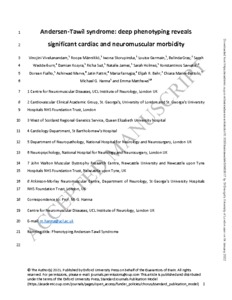Vivekanandam, V;
Männikkö, R;
Skorupinska, I;
Germain, L;
Gray, B;
Wedderburn, S;
Kozyra, D;
Sud, R;
James, N;
Holmes, S;
et al.
Vivekanandam, V; Männikkö, R; Skorupinska, I; Germain, L; Gray, B; Wedderburn, S; Kozyra, D; Sud, R; James, N; Holmes, S; Savvatis, K; Fialho, D; Merve, A; Pattni, J; Farrugia, M; Behr, ER; Marini-Bettolo, C; Hanna, MG; Matthews, E
(2022)
Andersen-Tawil syndrome: deep phenotyping reveals significant cardiac and neuromuscular morbidity.
Brain, 145 (6).
pp. 2108-2120.
ISSN 1460-2156
https://doi.org/10.1093/brain/awab445
SGUL Authors: Behr, Elijah Raphael Matthews, Emma Louise
![[img]](https://openaccess.sgul.ac.uk/113976/1.hassmallThumbnailVersion/awab445.pdf)  Preview |
|
PDF
Accepted Version
Available under License ["licenses_description_publisher" not defined].
Download (1MB)
| Preview
|
Abstract
Andersen Tawil Syndrome (ATS) is a neurological channelopathy caused by mutations in the KCNJ2 gene that encodes the ubiquitously expressed Kir2.1 potassium channel. The syndrome is characterised by episodic weakness, cardiac arrythmias and dysmorphic features. However, the full extent of the multi-system phenotype is not well described. In-depth, multi-system phenotyping is required to inform diagnosis, and guide management. We report our findings following deep multimodal phenotyping across all systems in a large case series of 69 total patients, with comprehensive data for 52. As a national referral centre, we assessed point prevalence and showed it is higher than previously reported, at 0.105 per 100 000 population in England. While the classical phenotype of episodic weakness is recognised, we found that a quarter of our cohort have fixed myopathy and 13.5% required a wheelchair or gait aid. We identified frequent fatty infiltration on MRI and tubular aggregates on muscle biopsy emphasising the active myopathic process underpinning the potential for severe neuromuscular disability. Long exercise testing (LET) was not reliable in predicting neuromuscular symptoms. A normal LET was seen in five patients of whom four had episodic weakness. 67% of patients treated with acetazolamide reported a good neuromuscular response. 13% of the cohort required cardiac defibrillator or pacemaker insertion. An additional 23% reported syncope. Baseline electrocardiograms were not helpful in stratifying cardiac risk, but holter monitoring was. A subset of patients had no cardiac symptoms, but had abnormal holter monitor recordings which prompted medication treatment. We describe the utility of loop recorders to guide management in two such asymptomatic patients. Micrognathia was the most commonly reported skeletal feature, however 8% of patients did not have dysmorphic features and one third of patients had only mild dysmorphic features. We describe novel phenotypic features including abnormal echocardiogram in nine patients, prominent pain, fatigue and fasciculations. Five patients exhibited executive dysfunction and slowed processing which may be linked to central expression of KCNJ2. We report eight new KCNJ2 variants with in vitro functional data. Our series illustrates that ATS is not benign. We report marked neuromuscular morbidity and cardiac risk with multi-system involvement. Our key recommendations include proactive genetic screening of all family members of a proband. This is required, given the risk of cardiac arrhythmias among asymptomatic individuals, and a significant subset of ATS patients have no (or few) dysmorphic features or negative LET. We discuss recommendations for increased cardiac surveillance and neuropsychometry testing.
| Item Type: |
Article
|
| Additional Information: |
This is a pre-copyedited, author-produced version of an article accepted for publication in Brain following peer review. The version of record Vinojini Vivekanandam, Roope Männikkö, Iwona Skorupinska, Louise Germain, Belinda Gray, Sarah Wedderburn, Damian Kozyra, Richa Sud, Natalie James, Sarah Holmes, Konstantinos Savvatis, Doreen Fialho, Ashirwad Merve, Jatin Pattni, Maria Farrugia, Elijah R Behr, Chiara Marini-Bettolo, Michael G Hanna, Emma Matthews, Andersen–Tawil syndrome: deep phenotyping reveals significant cardiac and neuromuscular morbidity, Brain, Volume 145, Issue 6, June 2022, Pages 2108–2120 is available online at: https://doi.org/10.1093/brain/awab445 |
| Keywords: |
Andersen Tawil syndrome, cardiac risk, channelopathy, muscle, periodic paralysis, Neurology & Neurosurgery, 11 Medical and Health Sciences, 17 Psychology and Cognitive Sciences |
| SGUL Research Institute / Research Centre: |
Academic Structure > Molecular and Clinical Sciences Research Institute (MCS) |
| Journal or Publication Title: |
Brain |
| ISSN: |
1460-2156 |
| Language: |
eng |
| Dates: |
| Date | Event |
|---|
| June 2022 | Published | | 17 December 2021 | Published Online | | 13 December 2021 | Accepted |
|
| Publisher License: |
Publisher's own licence |
| PubMed ID: |
34919635 |
 |
Go to PubMed abstract |
| URI: |
https://openaccess.sgul.ac.uk/id/eprint/113976 |
| Publisher's version: |
https://doi.org/10.1093/brain/awab445 |
Statistics
Item downloaded times since 04 Jan 2022.
Actions (login required)
 |
Edit Item |



